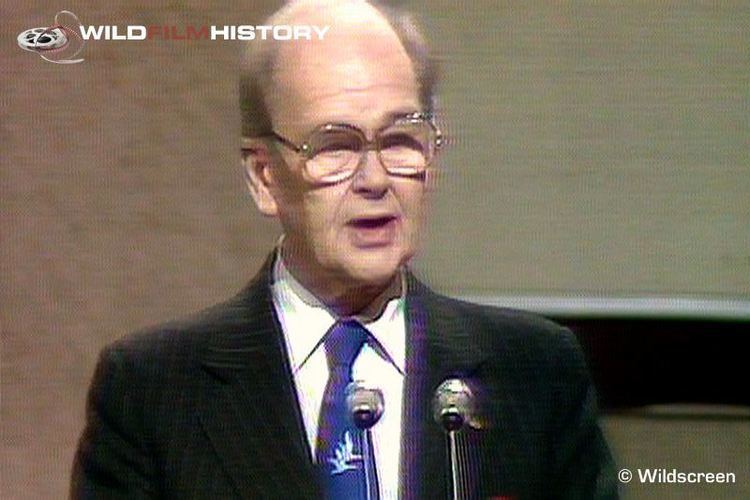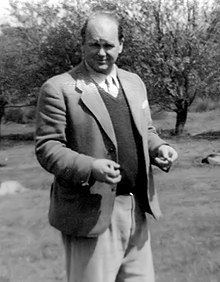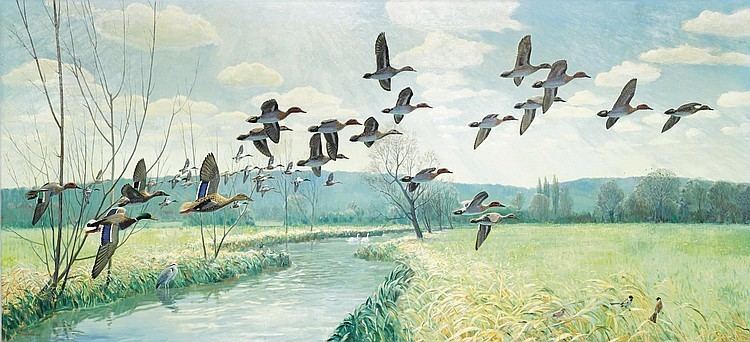Known for Conservation Name Peter Scott | Role Conservationist Movies Wild Wings | |
 | ||
Born 14 September 1909 ( 1909-09-14 ) London, England Monuments Statue of Sir Peter Scott at the WWT London Wetland Centre, busts at each of the Wildfowl & Wetlands Trust centres Occupation Ornithologist, conservationist, painter, naval officer and sportsman. Parents Robert Falcon Scott, Kathleen Scott Books The battle of the narrow se, A coloured key to the wildfowl o, Observations of wildlife Similar People Robert Falcon Scott, Kathleen Scott, Edward Max Nicholson, Julian Huxley, Elizabeth Jane Howard | ||
Sir peter scott debate 2008 part 1 of 5 introduction
Sir Peter Markham Scott, (14 September 1909 – 29 August 1989) was a British ornithologist, conservationist, painter, naval officer, broadcaster and sportsman. He was the only child of Robert Falcon Scott.
Contents
- Sir peter scott debate 2008 part 1 of 5 introduction
- Peter scott the new regime in english higher education
- Early life
- Art and sports
- Second World War
- Post war life
- Sailing
- World Wide Fund for Nature
- Loch Ness Monster
- British Naturalists Association
- Television documentaries
- Personal life
- Honours and decorations
- References

Scott was knighted in 1973 for his contribution to the conservation of wild animals. He had been a founder of the World Wide Fund for Nature, founded the Wildfowl & Wetlands Trust (November 1946), and was an influence on international conservation. He received the WWF Gold Medal and the J. Paul Getty Prize for his work.

Peter scott the new regime in english higher education
Early life

Scott was born in London, the only child of Antarctic explorer Robert Falcon Scott and sculptor Kathleen Bruce. He was only two years old when his father died. Robert Scott, in a last letter to his wife, advised her to "make the boy interested in natural history if you can; it is better than games." He was named after Sir Clements Markham, mentor of Scott's polar expeditions, and his godfather was J. M. Barrie, creator of Peter Pan.
He was educated at Oundle School and Trinity College, Cambridge, initially reading Natural Sciences but graduating in the History of Art in 1931. Whilst at Cambridge he shared digs with John Berry and the two shared many views.
Art and sports

Like his mother, he displayed a strong artistic talent and he became known as a painter of wildlife, particularly birds; he had his first exhibition in London in 1933. His wealthy background allowed him to follow his interests in art, wildlife and many sports, including wildfowling, sailing and ice skating. He represented Great Britain and Northern Ireland at sailing in the 1936 Berlin Olympic Games, winning a bronze medal in the O-Jolle dinghy class.
Second World War

During the Second World War, Scott served in the Royal Navy Volunteer Reserve. As a Sub-Lieutenant, during the failed evacuation of the 51st Highland Division he was the British Naval officer sent ashore at Saint-Valery-en-Caux in the early hours of 11 June 1940 to evacuate some of the wounded. This was the last evacuation of British troops from the port area of St Valery that was not disrupted by enemy fire.

Then he served in destroyers in the North Atlantic but later moved to commanding the First (and only) Squadron of Steam Gun Boats against German E-boats in the English Channel. He was awarded the Distinguished Service Cross for bravery. He participated in the Dieppe Raid on 19 August 1942.

Scott is credited with designing the Western Approaches ship camouflage scheme, which disguised the look of ship superstructure. In July 1940, he managed to get the destroyer HMS Broke (D83) in which he was serving experimentally camouflaged, differently on the two sides. To starboard, the ship was painted blue-grey all over, but with white in naturally shadowed areas as countershading, following the ideas of Abbott Handerson Thayer from the First World War. To port, the ship was painted in "bright pale colours" to combine some disruption of shape with the ability to fade out during the night, again with shadowed areas painted white. However, he later wrote that compromise was fatal to camouflage, and that invisibility at night (by painting ships in white or other pale colours) had to be the sole objective. By May 1941, all ships in the Western Approaches (the North Atlantic) were ordered to be painted in Scott's camouflage scheme. The scheme was said to be so effective that several British ships including HMS Broke collided with each other. The effectiveness of Scott's and Thayer's ideas was demonstrated experimentally by the Leamington Camouflage Centre in 1941. Under a cloudy overcast sky, the tests showed that a white ship could approach six miles (9.6 km) closer than a black-painted ship before being seen. For this work he was appointed a Member of the Order of the British Empire.
Post-war life
He stood as a Conservative in the 1945 general election in Wembley North and narrowly failed to be elected. In 1946, he founded the organisation with which he was ever afterwards closely associated, the Severn Wildfowl Trust (now the Wildfowl and Wetlands Trust) with its headquarters at Slimbridge in Gloucestershire. There, through a captive breeding programme, he saved the nene or Hawaiian goose, from extinction in the 1950s. In the years that followed, he led ornithological expeditions worldwide, and became a television personality, popularising the study of wildfowl and wetlands.
His BBC natural history series, Look, ran from 1955 to 1981 and made him a household name. It included the first BBC natural history film to be shown in colour, The Private Life of the Kingfisher (1968), which he narrated. He wrote and illustrated several books on the subject, including his autobiography, The Eye of the Wind (1961). In the 1950s, he also appeared regularly on BBC radio's Children's Hour, in the series, "Nature Parliament".
Scott took up gliding in 1956 and became a British champion in 1963. He was chairman of the British Gliding Association (BGA) for two years from 1968 and was president of the Bristol & Gloucestershire Gliding Club. He was responsible for involving Prince Philip in gliding; the Prince is still patron of the BGA.
He was the subject of This Is Your Life in 1956 when he was surprised by Eamonn Andrews at the King's Theatre, Hammersmith, London.
As a member of the Species Survival Commission of the International Union for Conservation of Nature and Natural Resources, he helped create the Red Data books, the group's lists of endangered species.
From 1973 to 1983, Scott was Chancellor of the University of Birmingham. In 1979, he was awarded an Honorary Degree (Doctor of Science) from the University of Bath. He died of a heart attack on 29 August 1989 in Bristol, two weeks before his 80th birthday.
He was the founder President of the Society of Wildlife Artists and President of the Nature in Art Trust (a role in which Philippa succeeded him). Scott tutored numerous artists including Paul Karslake.
Sailing
Scott also continued with his love of sailing, skippering the 12 metre yacht Sovereign in the 1964 challenge for the America's Cup which was held by the United States. Sovereign suffered a whitewash 4–0 defeat in a one-sided competition where the American boat had a faster design. From 1955 – 1969 he was the president of the International Sailing Federation
World Wide Fund for Nature
He was one of the founders of the World Wide Fund for Nature (formerly called the World Wildlife Fund), and designed its panda logo. His pioneering work in conservation also contributed greatly to the shift in policy of the International Whaling Commission and signing of the Antarctic Treaty, the latter inspired by his visit to his father's base on Ross Island in Antarctica.
Loch Ness Monster
In 1962, he co-founded the Loch Ness Phenomena Investigation Bureau with the then Conservative MP David James, who had previously been Polar Adviser on the 1948 movie based on his late father's polar expedition Scott of the Antarctic. In 1975 Scott proposed the scientific name of Nessiteras rhombopteryx for the Loch Ness Monster (based on a blurred underwater photograph of a supposed fin) so that it could be registered as an endangered species. The name was based on the Ancient Greek for "the monster of Ness with the diamond shaped fin", but it was later pointed out by The Daily Telegraph to be an anagram of "Monster hoax by Sir Peter S". Nessie researcher Robert H. Rines, who took two supposed pictures of the monster in the 1970s, responded by pointing out that the letters could also be read as an anagram for, "Yes, both pix are monsters, R."
British Naturalists' Association
Scott was a long-time Vice-President of the British Naturalists' Association, whose Peter Scott Memorial Award was instituted after his death, to commemorate his achievements.
Television documentaries
In June 2004, Scott and Sir David Attenborough were jointly profiled in the second of a three-part BBC Two series, The Way We Went Wild, about television wildlife presenters and were described as being largely responsible for the way that the British and much of the world views wildlife.
In 1996 Scott's life and work in wildlife conservation was celebrated in a major BBC Natural World documentary, produced by Andrew Cooper and narrated by Sir David Attenborough. Filmed across three continents from Hawaii to the Russian arctic, In the Eye of the Wind was the BBC Natural History Unit's tribute to Scott and the organisation he founded, the Wildfowl and Wetland Trust, on its 50th anniversary.
Scott's life was also the subject of a BBC Four documentary called Peter Scott – A Passion for Nature produced in 2006 by Available Light Productions (Bristol).
Personal life
Scott married the novelist Elizabeth Jane Howard in 1942 and had a daughter, Nicola, born a year later. Howard left Scott in 1946 and they were divorced in 1951.
In 1951, Scott married his assistant, Philippa Talbot-Ponsonby, while on an expedition to Iceland in search of the breeding grounds of the pink-footed goose. A daughter, Dafila, was born later in the same year (dafila is the old scientific name for a pintail). She, too, became an artist, painting birds. A son, Falcon, was born in 1954. Falcon Scott has worked part of the year giving lectures on educational cruises for Quark Expeditions.
Honours and decorations
On 8 July 1941, it was announced that Scott had been mentioned in despatches "for good services in rescuing survivors from a burning Vessel" while serving on HMS Broke. On 2 October 1942, it was announced that he had been further mentioned in despatches "for gallantry, daring and skill in the combined attack on Dieppe". On 1 June 1943, he was awarded the Distinguished Service Cross (DSC) "for skill and gallantry in action with enemy light forces".
He was appointed Member of the Order of the British Empire (MBE) in the 1942 Birthday Honours. He was promoted to Commander of the Order of the British Empire (CBE) in the 1953 Coronation Honours. He was knighted by Queen Elizabeth II at Buckingham Palace on 27 February 1973. In the 1987 Birthday Honours, he was appointed to the Order of the Companions of Honour (CH) "for services to conservation".
